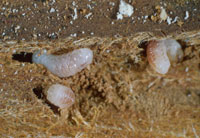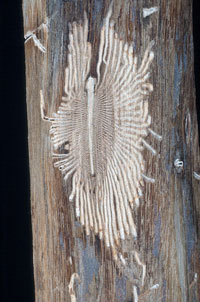Hyturgopinus rufipes
Host
Elm
Appearance and Life Cycle

Photo credit: Thérèse Arcand, Natural Resources Canada, Canadian Forest Service, Laurentian Forestry Centre
Adult beetles are dark brown to black, approximately 3 mm long and have a rough body surface with short, stiff, yellow hairs. There appears to be two distinct groups of beetles; one that overwinters in the outer bark near the base of living elms, and one that overwinters as larvae in the inner bark of dead elm wood. In both groups, the beetles breed and construct egg galleries in dead, dying and cut elm wood. The female constructs two egg galleries between the inner bark and the wood. The galleries are formed horizontally across the grain of the wood and resemble a broad, V-shaped angle. Minute, pearly white eggs are deposited close together along both sides of the galleries. Young larvae or grubs emerge from the eggs and construct feeding tunnels at right angles to the brood galleries, usually following the wood grain. Once full grown, the white, legless larvae pupate and emerge as adults. The emerging beetles that overwinter as larvae will be present in late June through July. The beetles that overwinter as adults will be present in late July through August. Both groups of beetles complete one generation per year in Canada.
Damage

Photo credit: Thérèse Arcand, Natural Resources Canada, Canadian Forest Service, Laurentain Forestry Centre
Native elm bark beetles carry the fungal spores of Dutch elm disease on their bodies. When the fungus is introduced into living elms, the water conducting vessels of the sapwood are blocked, killing the trees.
Control
Native elm bark beetle populations can be reduced by removing and destroying breeding sites; dead and dying elms. Healthy elm trees should not be pruned between April 1 and August 31, as beetles are strongly attracted to open tree wounds. Elm firewood should not be transported from one location to another. Chlorpyrifos applied to the lower two meters of the trunks of living elms during August will control the beetles.